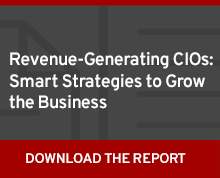As CIOs and IT leaders explore new ways to drive business value and generate revenue, figuring out how to monetize the products and services they’ve created within IT may be a good place to start. IDC predicts that by the end of 2017, "revenue growth from information-based products will be double that of the rest of the product/service portfolio for one-third of Global 2000 companies,” as noted in a recent report from Harvard Business Review Analytic Services.
[ Get the full report, including wisdom from 15 top CIOs: Revenue-generating CIOs: Smart strategies to grow the business. ]
GE’s transformation to a “digital industrial” company is a great example of this trend, and the successes the company has achieved on the way can be traced back to a strong vision and commitment from the top.
The report notes, “GE put in place a number of structures and resources to drive its transformation. But one of the strongest levers for change may have come from a simple statement by the CEO. When asked by an investor what his backup plan was for the digital industrial future, CEO Jeffrey Immelt said there was no backup plan.”
Snapshot: GE FieldVision

What it is: GE FieldVision is “a persona-based mobile app that aggregates data from 86 different systems to make field engineers more productive at customers’ sites. Engineers who want to access a drawing, get work instructions, collaborate with another engineer, or track time or parts only need to access this one application.”
Challenge and opportunity: The project was initiated by a senior IT leader in the power business who sought to better understand how field engineers did their work and whether the process could be improved. The mobile app took off, and since then, “the company has improved data collection and analytics on the FieldVision platform through the use of thermal imaging and algorithms that do comparative analysis to see if heat signatures on power plant equipment have changed. This alerts them to potential problems before equipment fails, allowing for predictive maintenance. The use of drones has taken this a step further, enabling such analysis and monitoring even when a field engineer is not on-site – especially helpful in remote locations. Similarly, the use of 3D imaging and virtual reality lets on-site customer employees take 3D images of parts and work with GE engineers through the cloud to help diagnose and potentially resolve problems rather than waiting days to fly in an available engineer.”
Outcomes: According to the report, as a direct result of these efforts, “the company realized productivity gains of $200 million. The application has since been rolled out across GE, not just in the power business. And in the ultimate application of top-line IT, such internally developed capabilities, including FieldVision, are being further developed to be sold as services to customers.”




